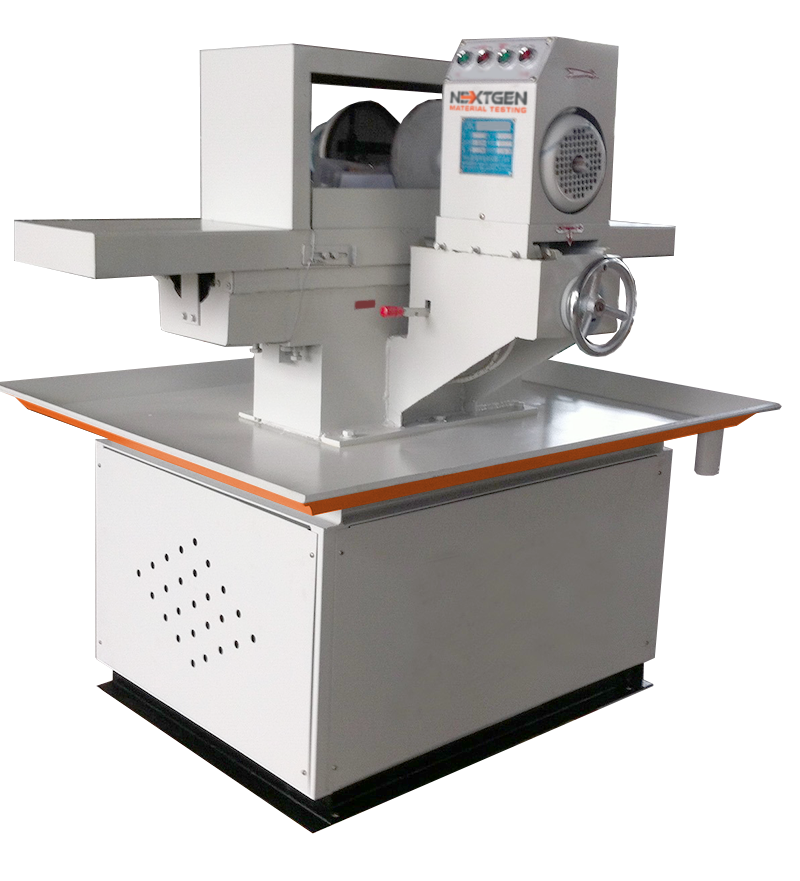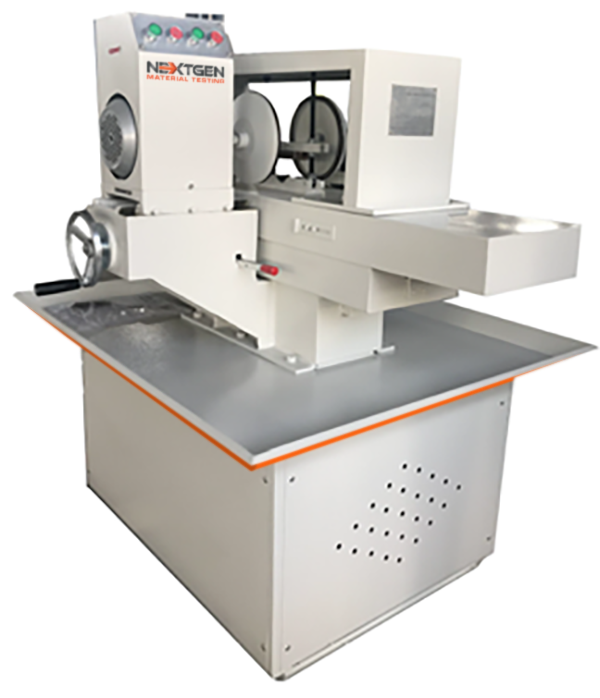Rock Mechanics Testing Equipment
Standards
ASTM D4543, ASTM C42, EN 12390-3, EN 12504-1






Description
Introducing NextGen's cutting-edge NG-CoreGrind 2000 automatic double faced core grinder machine, specifically designed to expertly grind and polish the end surfaces of concrete or rock cube and cylinder specimens. This state-of-the-art equipment boasts two flexible grinding heads, each outfitted with 8-inch (⌀ 200mm) diamond grinding wheels, ensuring exceptional precision and high-quality performance. The NG-CoreGrind 2000 diligently meets parallelism requirements set by industry standards and complies with ASTM D4543 & ASTM C42 international standards.
Designed for maximum efficiency and ease of use, our automatic grinder machine features a user-friendly table that easily locks the cube and cylinder specimens in place. The grinding head can then be laterally moved, either manually or automatically, in both directions, with adjustable speed for optimal control. Learn more in our latest mega blog.
Whether you're in the construction industry or working in a geology lab, our automatic grinder machine is the perfect solution for achieving a flawless finish on your cube and cylinder specimens. With its advanced features and cutting-edge technology, this machine is sure to exceed your expectations and help you achieve outstanding results every time.
NG-CoreGrind 2000 Double Faced Core Grinder Machine Main Features
-
The NG-CoreGrind 2000 is designed to make the process of grinding concrete cubes or cylinders easier and more precise than ever before. Boasting a large base table, this machine delivers exceptional productivity, allowing you to grind multiple specimens quickly and efficiently.
-
Thanks to its ergonomic, compact bench model design, our grinding machine is the perfect solution for laboratories that are tight on space. Not only does this machine help you save valuable real estate, but it also enhances laboratory safety.
-
Our grinder machine also features an advanced cooling system, which can be powered by either a main water supply or a recirculating system. This feature greatly improves reliability, ensuring that the machine performs consistently and reliably, even during extended use.
NG-CoreGrind 2000 Standard Configuration
-
NG-CoreGrind 2000 Main Machine
-
Diamond Grinding Wheels
-
Clamping Devices
-
Operation Manual
NG-CoreGrind 2000 Double Faced Core Grinder Machine Technical Specifications
|
NG-CoreGrind 2000 |
|
|---|---|
|
Motor |
.75kW Speed 1,430rpm |
|
Power for Grinding Head |
1.1kW x2 Speed 2,800rpm |
|
Grinding Mode |
Parallel grinding of both surface ends simultaneously |
|
Grinding Head Control Modes |
Manual or Automatic |
|
Automatic Grind Feeding Speeds |
0.04-0.2mm (adjustable) |
|
Maximum Specimen Sizes |
Cubes (in): 1.97"x1.97"x1.97" to 5.91"x5.91"x5.91" Cubes (cm): 50x50x50mm to 150x150x150 mm 1.97" Dia. To 5.91" Dia. 50mm Dia. To 150mm Dia. |
|
Surface Fineness |
Ra3.2 |
|
Flatness and Precision |
Error ≤0.04mm, Verticality ≤0.1mm |
|
Grinding Wheels |
⌀ 8" x ⌀ 0.75"x1.57", 2pcs ⌀ 200 × ⌀ 19×40mm, 2pcs |
|
Cooling Devices |
Water Cooling, Liquid Nitrogen Cooling (optional) |
|
Dimensions |
58" x 56" x 48" 1,450mm x 1,400mm x 1,200mm |
|
Weight |
1323 lbs / 600 kg |
FAQs
The Double Faced Rock Core Grinder Machine – NG-CoreGrind 2000 is specifically designed to grind and polish the end surfaces of rock and concrete cube or cylinder specimens. It confirms that the ends of these specimens meet strict parallelism requirements for accurate testing and analysis. It is essential to achieve this level of precision in rock mechanics, construction, and geological laboratories where flawless sample preparation is essential for reliable test results.
With its two 8-inch diamond grinding wheels, the NG-CoreGrind 2000 can grind both ends of a sample simultaneously, providing consistent and parallel surfaces. This machine is commonly used in laboratories to prepare samples for further strength and durability testing, thus serving as an indispensable research and industrial tool.
Click here to learn more about the product or here to receive a personalized quote.
The Double Faced Rock Core Grinder Machine – NG-CoreGrind 2000 features two flexible grinding heads, each equipped with 8-inch (⌀ 200mm) diamond grinding wheels. These high-quality diamond wheels deliver exceptional precision when grinding and polishing rock or concrete specimen end surfaces. The two grinding heads work simultaneously, allowing the machine to grind both ends of the sample at the same time, thereby guaranteeing parallelism and uniformity.
This dual-head configuration provides high performance and efficiency, significantly speeding up sample preparation for further testing. Diamond grinding wheels guarantee durability and long-term sharpness, which is necessary for consistent results. This design is particularly valuable in labs where precision and speed are critical for preparing rock or concrete samples for mechanical and structural analysis.
Click here to learn more about the product or here to receive a personalized quote.
Yes, the NG-CoreGrind 2000 complies with multiple international industry standards, including ASTM D4543, ASTM C42, EN 12390-3, and EN 12504-1. These standards define the necessary specifications for grinding and preparing rock and concrete core samples with accurate parallelism, surface flatness, and precision.
By meeting these stringent requirements, the NG-CoreGrind 2000 makes certain that the ends of the specimens are ground to the exact parallelism and flatness needed for further mechanical and strength testing. Compliance with these standards is critical for labs and industries that rely on precise sample preparation for accurate, reproducible test results. This makes the machine suitable for a range of applications, including construction, geology, and material science research, where international testing guidelines must be followed.
Click here to learn more about the product or here to receive a personalized quote.
Yes, the NG-CoreGrind 2000 complies with ASTM D4543, a key standard that outlines the procedures for preparing rock core specimens using saws and grinders. Specifically, ASTM D4543 guarantees that rock or concrete specimens are ground with precise parallelism, flatness, and perpendicularity on their end surfaces.
This standard is extremely important for laboratories that test rock or concrete samples for properties such as compressive strength, as it guarantees that the samples are properly prepared for reliable and reproducible results. The NG-CoreGrind 2000 meets these exacting specifications, making it a valuable tool for industries that require ASTM-compliant sample preparation to conduct high-precision testing in accordance with global standards.
Click here to learn more about the product or here to receive a personalized quote.
Yes, the NG-CoreGrind 2000 complies with ASTM C42, an international standard for obtaining and preparing drilled core specimens of concrete. ASTM C42 specifies methods for extracting cylindrical core samples from concrete structures and preparing them for testing, such as for determining compressive strength.
This standard outlines requirements for the size, preparation, and condition of core samples to ensure accurate and reliable testing results. The NG-CoreGrind 2000 is designed to grind and prepare the ends of these cylindrical cores, making sure that they meet the required parallelism and surface flatness, as stipulated by ASTM C42. It is imperative for construction and material testing to adhere to this standard, as it ensures that the specimens will produce meaningful and standardized results as a result of proper preparation.
Click here to learn more about the product or here to receive a personalized quote.
Yes, the NG-CoreGrind 2000 complies with EN 12390-3, which is a European standard that specifies the testing of hardened concrete, particularly in terms of compressive strength. EN 12390-3 outlines the procedures for preparing and testing concrete specimens—such as cubes and cylinders—under compression to determine their strength and performance in construction applications.
This standard requires concrete specimens to have perfectly parallel, flat ends to provide uniform load distribution during testing. The NG-CoreGrind 2000 is specifically developed to meet these strict requirements by precisely grinding and polishing the end surfaces of the specimens, ensuring they comply with EN 12390-3. This compliance makes the machine highly valuable for laboratories and industries involved in concrete strength testing, allowing them to produce reliable and consistent results in accordance with European standards.
Click here to learn more about the product or here to receive a personalized quote.
Yes, the NG-CoreGrind 2000 complies with EN 12504-1, a European standard that specifies methods for testing concrete in structures by extracting core samples and preparing them for further testing, such as determining compressive strength. EN 12504-1 focuses on the procedure for taking core samples from hardened concrete and making sure that the cores are properly prepared for testing, including verifying that the ends of the cores are flat and parallel.
The NG-CoreGrind 2000 is designed to meet the precision and parallelism requirements set by this standard, assuring that concrete cores are ground and prepared to the exact specifications needed for reliable strength testing. Compliance with EN 12504-1 is crucial for the construction and engineering sectors, as it guarantees that specimens are accurately prepared, leading to trustworthy testing outcomes that comply with European regulations.
Click here to learn more about the product or here to receive a personalized quote.
The NG-CoreGrind 2000 is built for maximum efficiency and ease of use, featuring a user-friendly table that securely locks cube and cylinder specimens in place. This table allows for quick and straightforward specimen setup so that the samples are held firmly during grinding. Whether working with concrete cubes or cylindrical rock cores, the locking mechanism guarantees stability and prevents movement, an important factor for precise and parallel grinding results.
This ergonomic design simplifies the specimen preparation process, reducing the time and effort needed to set up each test, while also guaranteeing that the samples are prepared accurately for further testing. The combination of ease of use and precision helps labs and technicians achieve consistent results, making the NG-CoreGrind 2000 a highly efficient and reliable tool for preparing rock and concrete specimens.
Click here to learn more about the product or here to receive a personalized quote.
The NG-CoreGrind 2000 provides users with flexibility and control through its grinding head, which can be moved laterally in both directions, either manually or automatically. This design allows for smooth and precise positioning of the grinding head, giving users the ability to tailor the grinding process to specific requirements. The machine also features adjustable speed control, enabling the operator to set the grinding head speed to suit the material and the task at hand.
This combination of manual and automatic movement, along with speed adjustability, provides optimal control over the grinding process, making certain that each specimen is ground with precision. This flexibility is particularly helpful for achieving uniform, parallel surfaces on rock or concrete samples, essential for accurate testing results. For laboratories working with a variety of specimens, these features make the NG-CoreGrind 2000 is a versatile and efficient tool.
Click here to learn more about the product or here to receive a personalized quote.
Yes, the NG-CoreGrind 2000 is an ideal solution for both construction and geology laboratories. Whether you need to prepare concrete specimens in a construction lab or rock samples in a geology lab, this machine offers the functionality and precision necessary in both fields. With its advanced features, such as dual grinding heads, user-friendly design, and adjustable control settings, the NG-CoreGrind 2000 provides flawless surface finishes on cube and cylinder specimens.
The machine’s ability to deliver consistent and precise grinding guarantees that samples meet the strict requirements for testing in both industries, such as compressive strength and durability. Its cutting-edge technology and robust performance make it a valuable asset, helping operators achieve outstanding results efficiently, every time.
Click here to learn more about the product or here to receive a personalized quote.
The NG-CoreGrind 2000 features an ergonomic, compact bench model design, making it a perfect solution for laboratories with limited space. Its small footprint allows labs to save valuable workspace without compromising functionality or performance. This space-efficient design is particularly beneficial for laboratories where space is limited, enabling operators to set up the machine in tight environments while still enjoying full access to its powerful grinding capabilities.
In addition to saving space, the NG-CoreGrind 2000's compact design also increases laboratory safety. The ergonomic structure ensures that all controls and components are easily accessible, reducing the risk of strain or accidents during operation. The machine’s size and layout are thoughtfully designed to maximize efficiency while maintaining a safe and organized lab environment, which makes it a suitable choice for laboratories that perform rock and concrete tests on a regular basis.
Click here to learn more about the product or here to receive a personalized quote.
The NG-CoreGrind 2000 features an advanced cooling system that can be powered by either a main water supply or a recirculating system, offering flexibility depending on the lab’s setup. This cooling system has a significant role to play in maintaining consistent machine performance, especially during extended grinding sessions. Cooling the grinding wheels and surfaces helps prevent overheating, which can lead to wear or damage to the grinding components and reduced precision in the grinding process.
This feature ensures that the NG-CoreGrind 2000 operates reliably and maintains exceptional performance over long periods of use, which makes it an excellent choice for laboratories with high specimen throughput. The cooling system not only enhances the machine’s durability but also ensures grinding operations remain precise and efficient, contributing to high-quality, repeatable results. Whether working with a continuous water supply or a closed recirculating system, the cooling function supports the grinder's long-term reliability and effectiveness.
Click here to learn more about the product or here to receive a personalized quote.
The NG-CoreGrind 2000 comes with a standard configuration that includes several key components required for its operation. These include:
-
NG-CoreGrind 2000 Main Machine: The core unit of the machine is responsible for grinding and polishing rock and concrete specimens.
-
Diamond Grinding Wheels: High-quality, durable diamond grinding wheels, designed to grind specimen ends precisely and efficiently.
-
Clamping Devices: These devices securely hold the specimens (cubes or cylinders) in place during grinding.
-
Operation Manual: A detailed guide providing instructions on how to properly operate the machine, including setup, safety guidelines, and maintenance.
With this standard configuration, users are able to operate the NG-CoreGrind 2000 efficiently right out of the box, allowing for the precise and safe preparation of stone and concrete samples.
Click here to learn more about the product or here to receive a personalized quote.
The NG-CoreGrind 2000 is powered by a .75kW motor that operates at 1,430 revolutions per minute (rpm). This motor provides the necessary torque and power to provide smooth and efficient grinding of rock and concrete specimens. The high-speed motor ensures precise and rapid grinding, helping labs prepare samples quickly without compromising on quality.
This power specification allows the NG-CoreGrind 2000 to handle a wide variety of specimen types and sizes while maintaining consistent performance, allowing it to be used for high-precision applications in both geological and construction material testing. The motor's combination of power and speed guarantees reliability during extended use, contributing to the machine's overall efficiency and productivity.
Click here to learn more about the product or here to receive a personalized quote.
The NG-CoreGrind 2000 is equipped with two grinding heads, each powered by a 1.1kW motor that operates at 2,800 revolutions per minute (rpm). This powerful setup assures that both grinding heads work efficiently to grind and polish rock or concrete specimen end surfaces simultaneously.
The high-speed motors driving the grinding heads allow for precise, quick, and smooth grinding, so specimen preparation is accurate with minimal effort. This dual-head configuration significantly increases the productivity of the machine, enabling it to handle a broad array of samples in laboratories where speed and accuracy are critical. The combination of two 1.1kW motors at 2,800rpm provides high reliability, even under continuous use.
Click here to learn more about the product or here to receive a personalized quote.
The NG-CoreGrind 2000 operates in parallel grinding mode, meaning it simultaneously grinds both the surface ends of rock or concrete specimens. This mode makes sure that the ends of cylindrical or cube specimens are ground uniformly and parallel to each other, which is critical for accurate and reliable testing results.
By grinding both ends at the same time, the NG-CoreGrind 2000 improves efficiency and reduces specimen preparation time. This parallel grinding feature is necessary for achieving the precision and flatness required in mechanical testing, such as compressive strength tests, where perfectly parallel surfaces are crucial for distributing loads evenly across the sample. This mode of operation makes the NG-CoreGrind 2000 an ideal solution for high-precision laboratory work.
Click here to learn more about the product or here to receive a personalized quote.
The NG-CoreGrind 2000 offers two grinding head control modes: manual and automatic. In the manual mode, operators can directly control the movement of the grinding heads, allowing for more hands-on adjustment and precise control during the grinding process. This mode is useful for fine-tuning the grinding process when working with irregular or delicate specimens.
In automatic mode, the machine controls the movement of the grinding heads, providing a more streamlined and efficient grinding process. This is particularly beneficial for laboratories with high specimen throughput, as it reduces the need for constant operator intervention and allows for consistent grinding of multiple samples.
The flexibility of switching between manual and automatic modes allows the NG-CoreGrind 2000 to adapt to different testing environments and operator preferences, giving it the ability to serve a wide variety of sample preparation requirements.
Click here to learn more about the product or here to receive a personalized quote.
The NG-CoreGrind 2000 features automatic grind feeding speeds adjustable between 0.04 mm to 0.2 mm. This range allows operators to control the rate at which the grinding heads move toward the specimen during the grinding process. The adjustable feed speed makes it possible for the grinding process to be tailored to the specific material and sample requirements, allowing for fine-tuning when precision is needed or faster grinding for less delicate materials.
By providing a flexible speed range, the NG-CoreGrind 2000 increases specimen preparation efficiency and accuracy, making certain that both the grinding process and the resulting surfaces are of high quality. The adjustability of the feed speeds also helps reduce wear on the grinding wheels by optimizing the pressure and speed according to the material's hardness.
Click here to learn more about the product or here to receive a personalized quote.
The NG-CoreGrind 2000 can work with a range of specimen sizes. For cubes, it accommodates dimensions from 1.97" x 1.97" x 1.97" to 5.91" x 5.91" x 5.91" (or 50 x 50 x 50 mm to 150 x 150 x 150 mm). For cylindrical specimens, it supports diameters ranging from 1.97 inches (50 mm) to 5.91 inches (150 mm).
This extensive range of specimen sizes allows the machine to process both small and large samples, allowing it to be used for different testing needs. Whether working with smaller cube specimens or larger cylindrical cores, the NG-CoreGrind 2000 delivers precise grinding across the entire size range, meeting different testing requirements in rock mechanics, construction, and geology labs.
Click here to learn more about the product or here to receive a personalized quote.
The NG-CoreGrind 2000 achieves a surface fineness of Ra3.2, which refers to the roughness average, a measure of the smoothness of the specimen’s surface after grinding. A Ra3.2 value indicates that the surface is sufficiently smooth for accurate testing, particularly in mechanical and compressive strength assessments. This level of fineness is necessary in order to ensure consistent contact during testing, preventing irregularities that could lead to inaccurate results.
The surface fineness of Ra3.2 indicates that the NG-CoreGrind 2000 can produce high-quality finishes, which is an ideal solution for laboratories that require precise, smooth surfaces on their rock or concrete specimens for reliable and repeatable testing outcomes.
Click here to learn more about the product or here to receive a personalized quote.
The NG-CoreGrind 2000 offers high flatness and precision during the grinding process, with an error of ≤0.04mm and a verticality tolerance of ≤0.1mm. These specifications make sure that the specimen surfaces are ground with extremely high accuracy, a requirement for reliable and consistent testing results, especially in the evaluation of compressive strength and mechanical performance of samples.
The flatness tolerance of ≤0.04mm guarantees that the ends of the cube or cylindrical specimens are uniformly flat, allowing for even load distribution during testing. Similarly, the verticality tolerance of ≤0.1mm makes certain that the specimens are aligned perfectly upright, preventing misalignment that could affect test outcomes. These precision metrics make the NG-CoreGrind 2000 highly reliable for laboratories requiring exact sample preparation to rigorous testing standards.
Click here to learn more about the product or here to receive a personalized quote.
The NG-CoreGrind 2000 is equipped with two grinding wheels, each with dimensions of ⌀ 8" x ⌀ 0.75" x 1.57" or ⌀ 200mm x ⌀ 19mm x 40mm. These diamond grinding wheels are designed for the precision grinding of rock and concrete specimens, making certain that both ends of the samples are ground evenly and to exact specifications.
The two grinding wheels allow for simultaneous grinding at both ends, increasing efficiency while maintaining the high accuracy required for testing samples. The diamond material provides long-lasting durability and high performance, making the NG-CoreGrind 2000 ideal for laboratories that require consistent sample preparation results.
Click here to learn more about the product or here to receive a personalized quote.
The NG-CoreGrind 2000 offers two cooling options to maintain optimal performance during grinding. The standard water cooling system uses a continuous flow of water to prevent overheating of the grinding wheels and the specimen, resulting in consistent performance over extended periods of use. This cooling method protects grinding components and makes sure that the surface finish remains smooth and precise.
Additionally, the NG-CoreGrind 2000 can be fitted with an optional liquid nitrogen cooling system. This cooling option is particularly useful for more demanding applications where extreme cooling is necessary, such as working with particularly hard materials or extending grinding operations. Cooling systems contribute to machine reliability and ensure smooth, uninterrupted operation, even during intensive grinding sessions.
Click here to learn more about the product or here to receive a personalized quote.
The NG-CoreGrind 2000 has dimensions of 58" x 56" x 48" (or 1,450mm x 1,400mm x 1,200mm). These dimensions reflect the compact yet sturdy design of the machine, allowing it to be used in laboratories that require efficient use of space. Despite its compact size, the NG-CoreGrind 2000 provides ample capacity for handling a range of specimen sizes and delivers high precision in grinding and polishing processes.
These dimensions are necessary for determining the appropriate space requirements in a laboratory setting so that the machine can be installed and operated comfortably without taking up excessive room. Its well-thought-out design balances performance with efficient use of space.
Click here to learn more about the product or here to receive a personalized quote.
The NG-CoreGrind 2000 weighs 1,323 lbs (600 kg). This substantial weight provides the machine's stability during operation, minimizing vibrations and movement that could affect the grinding process' precision. Sturdy construction is vital for handling heavy-duty grinding tasks on rock and concrete specimens, providing both durability and reliability over time.
Understanding the machine's weight is also important for planning installation, as it may require a stable and reinforced surface to support its operation. The weight reflects the heavy-duty nature of the NG-CoreGrind 2000, thus making it suitable for use in rock mechanics and material testing laboratories.
Click here to learn more about the product or here to receive a personalized quote.
Related Products
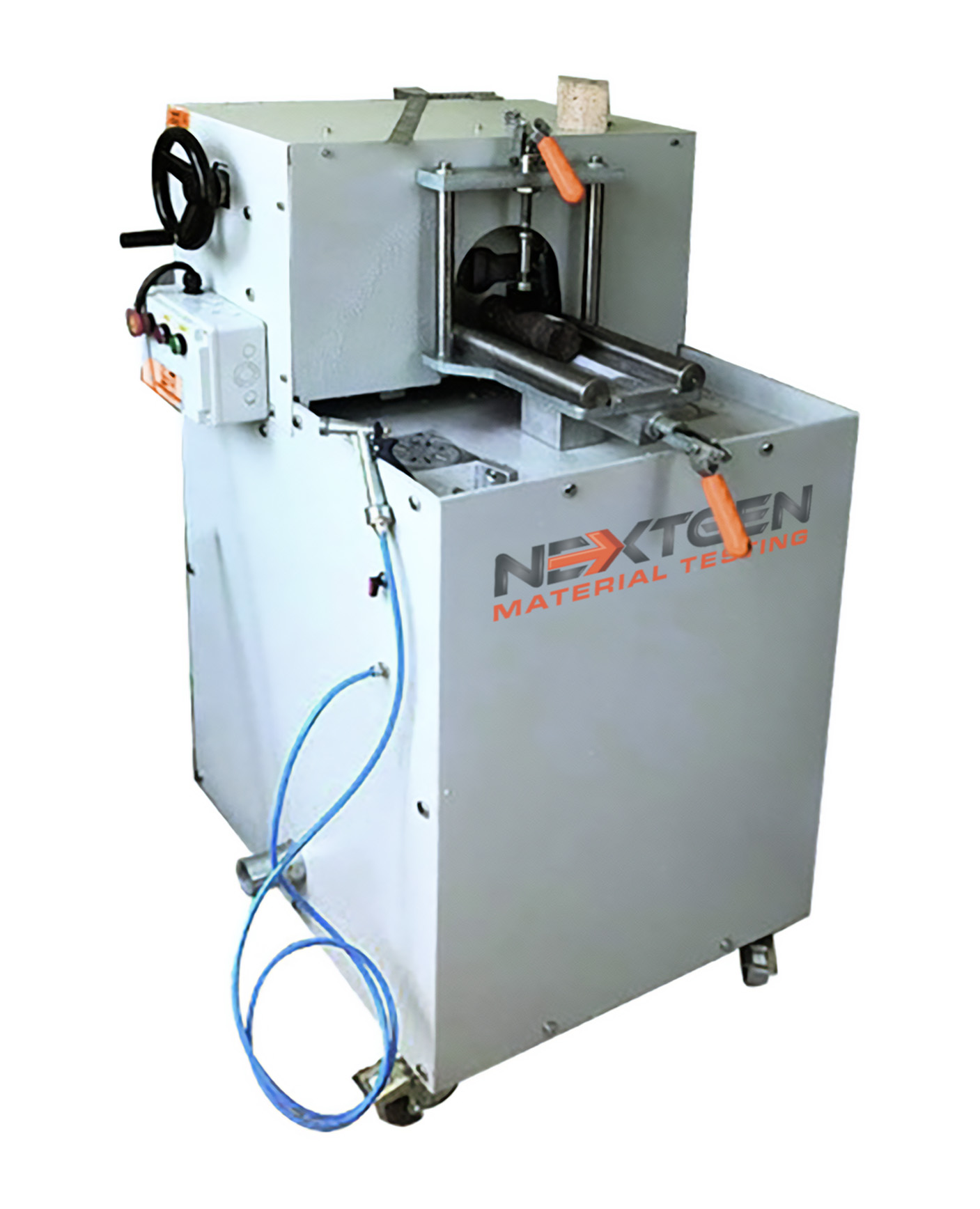
Semi-Automatic Core Grinding Machine - NG-CoreGrind 1000
Our Semi-Automatic Core Grinding Machine (also known as Coregrinder or Core Grinder) is the preferred alternative to the traditional rubber / sulfur capping methods used by Quality Labs
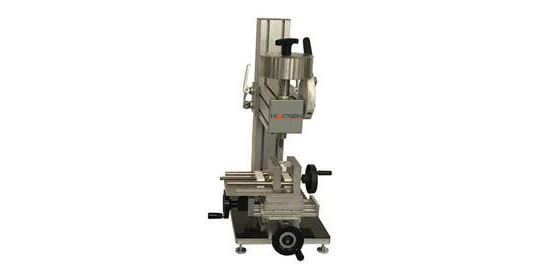
West Cerchar Abrasivity Index Tester
Description The West Cerchar Abrasivity Index Tester is designed to determine the rock abrasivity index (CAI) for the purpose of quantifying the classification of rock materials abrasivity. This type of test is especially valuable in the mining industries, underground construction […]
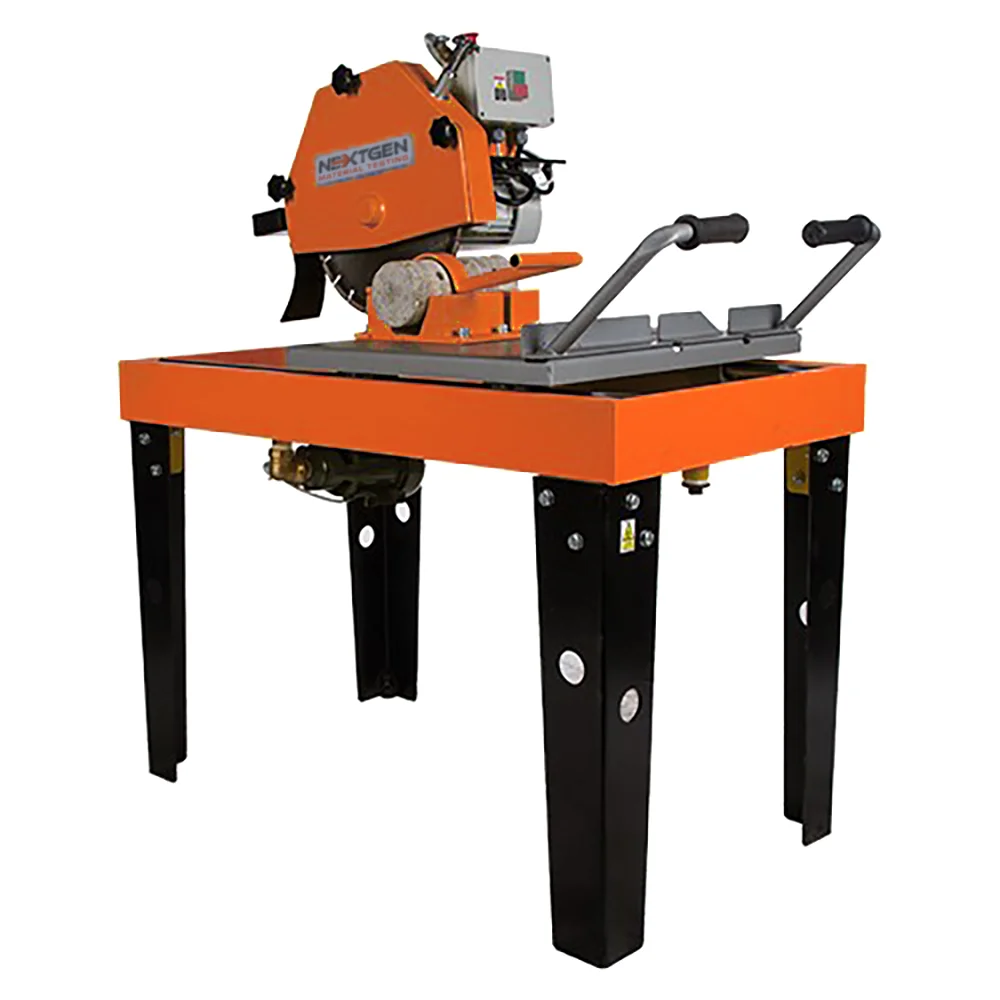
Rock Core Cutter and Masonry Saw
Our Rock Core Cutter and Masonry Saw designed for preparing concrete, rock, or natural stone cores and test specimens.
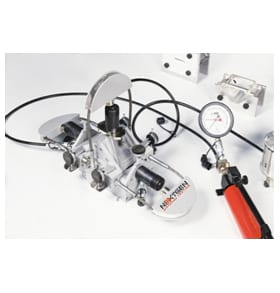
Rock Shear Box Apparatus
This apparatus was originally developed at Imperial College, London, by Professor E. Hoek. It is a simple and practical method of determining the strength and slope stability of rock, both in the field and in the laboratory.
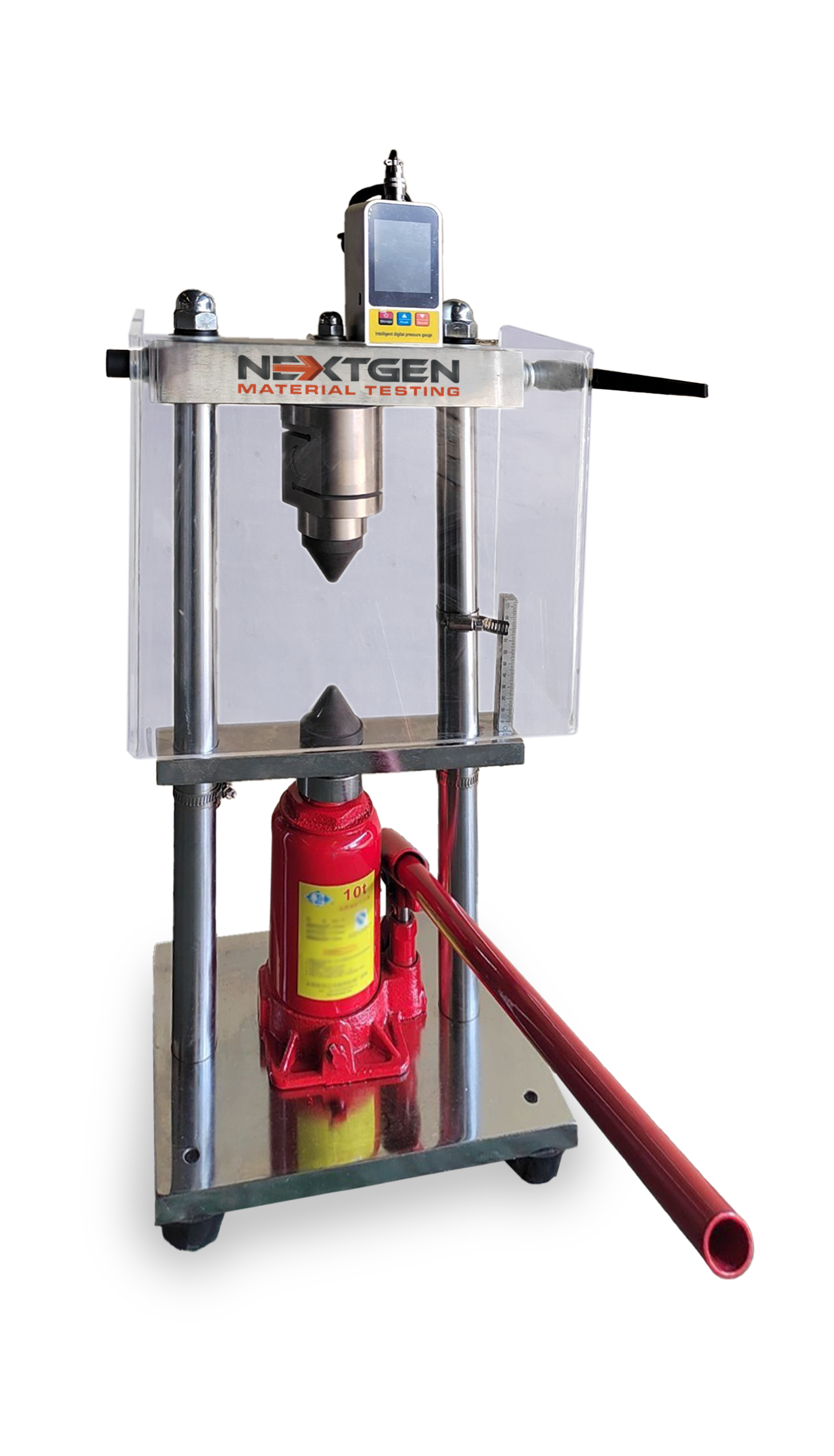
Point Load Tester: Portable Rock Strength Testing for Field Applications
Discover the high-precision Point Load Tester for fast and reliable rock strength testing as a cost-effective solution for geotechnical and construction projects.
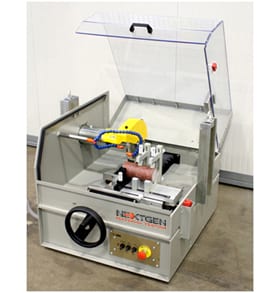
Core Trimmer and Cut-Off Machine - NG-CoreTrim
NG-CoreTrim is used to obtain rock samples perfectly machined (cube, prisms, etc) from irregular rock or core pieces. It is supplied complete with a proper vice to hold irregular pieces firmly in place up to 7x14
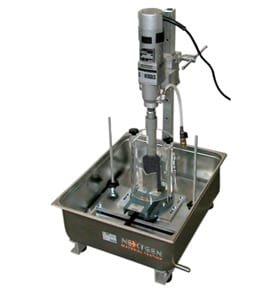
Laboratory Coring Machine and Bits
This machine is specifically used in the laboratory for cutting core samples from hard materials such as rock and concrete.
